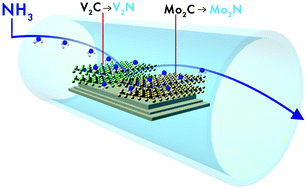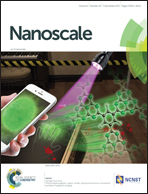2D molybdenum and vanadium nitrides synthesized by ammoniation of 2D transition metal carbides (MXenes)†
Abstract
MXenes are a rapidly growing class of 2D transition metal carbides and nitrides, finding applications in fields ranging from energy storage to electromagnetic interference shielding and transparent conductive coatings. However, while more than 20 carbide MXenes have already been synthesized, Ti4N3 and Ti2N are the only nitride MXenes reported so far. Here by ammoniation of Mo2CTx and V2CTx MXenes at 600 °C, we report on their transformation to 2D metal nitrides. Carbon atoms in the precursor MXenes are replaced with N atoms, resulting from the decomposition of ammonia molecules. The crystal structures of the resulting Mo2N and V2N were determined with transmission electron microscopy and X-ray pair distribution function analysis. Our results indicate that Mo2N retains the MXene structure and V2C transforms to a mixed layered structure of trigonal V2N and cubic VN. Temperature-dependent resistivity measurements of the nitrides reveal that they exhibit metallic conductivity, as opposed to semiconductor-like behavior of their parent carbides. As important, room-temperature electrical conductivity values of Mo2N and V2N are three and one order of magnitude larger than those of the Mo2CTx and V2CTx precursors, respectively. This study shows how gas treatment synthesis such as ammoniation can transform carbide MXenes into 2D nitrides with higher electrical conductivities and metallic behavior, opening a new avenue in 2D materials synthesis.



 Please wait while we load your content...
Please wait while we load your content...